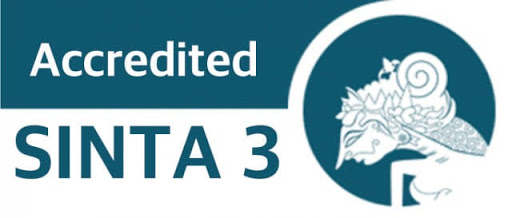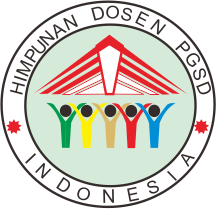IMPROVING STUDENTS’ LEARNING OUTCOMES THROUGH THE MEDIA OF SUNDA MANDA TRADITIONAL GAME
Abstract
This study aimed to improve students’ learning outcomes through the media of Sunda Manda game. This study was Classroom Action Research (CAR) based on Kemmis and Mc. Taggart which included two cycles. Each cycle consisted of three meetings with four stages namely planning, implementing, observing, and reflecting. This study was conducted at grade IV elementary school involving 37 students as the research subjects. Data were collected through observation, interview, and documentation. Then, the analysis of the data of this research was conducted by using interviews, questionnaires, and documentation. The result of this study showed an increase in students’ learning outcomes. Findings revealed that in Cycle I, 26 students reached the target score with an average of 72.76 (70.27%) for social science and 25 students reached the target schore with an average of 73.49 (67.57%) for Bahasa Indonesia.. Then, in Cycle II, 34 students reached the target with an average of 80.21 (91. 89%) for social science, and 32 students reached the target with an average of 79,51 (86,49%) for Bahasa Indonesia. Furthermore, the average score of the learning outcomes for the affective aspect in Cycle I was 74.38 (61.98%) and it increased to 96 (80.00%) in Cycle II. In addition, the learning outcomes for skills in Cycle I was 51.76 (61.62%) and it increased to 66.84 (79.57%) in cycle II. This research implied that the innovation of media like Sunda Manda traditional game improved the learning outcomes of students at grade IV elementary school. Thus, it was concluded that there was an increase in the students’ learning outcomes through the media of Sunda Manda traditional game.
Keywords
Full Text:
PDF (ENGLISH)References
Astuti, N. A. I. (2020). Keefektifan Metode Inkuiri Berbantu Media SMART CARD (Kartu Pintar) Terhadap Hasil Belajar Ditinjau Dari Motivasi Siswa Kelas IV SD Negeri 1 Sambiyan Pada Pembelajaran Tematik. EduHumaniora: Jurnal Pendidikan Dasar. Vol 12. No 1. Hal 69-75. P-ISSN 2085-1243. E-ISSN 2579-5457.
Daryanto. (2015). Media Pembelajaran. Bandung: PT. Sarana Tutorial Nurani Sejahtera.
Fadhilah, N., Renda, N. T., Jayanta, I. N. L. (2020). Hubungan Antara Daya Ketahanmalangan dan Minat Belajar Dengan Hasil Belajar Matematika Siswa. EduHumaniora: Jurnal Pendidikan Dasar. Vol 12. No 1. Hal 37-47. P-ISSN 2085-1243. E-ISSN 2579-5457.
Gunawan, I., dan Palupi, A. R. (2012). Taksonomi Bloom-Revisi Ranah Kognitif: Kerangka Landasan Untuk Pembelajaran, Pengajaran, dan Penilaian. Jurnal Pendidikan Dasar dan Pembelajaran. Volume 2. Nomor 02.
Hidayani, M. (2016). Pembelajaran Tematik Dalam Kurikulum 2013. At-Ta’lim. Vol 15. No 1. Hal 150-165.
Kemendikbud. (2013). Pengembangan Kurikulum 2013. Paparan mendikbud dalam sosialisasi kurikulum. Jakarta: Kemendikbud.
Prihastari, E. B. (2015). Pemanfaatan Etnomatematik Melalui Permainan Engklek Sebagai Sumber Belajar. Jurnal Kajian Pendidikan dan Pengajaran. Volume 1. Nomor 2. Halaman 155-162. ISSN 2443-1435.
Purwanto. (2013). Evaluasi Hasil Belajar. Yogyakarta: Pustaka Belajar.
Ridlo, H. T., Abdurakhman, O., & Pradana, Y. (2015). Meningkatkan Motivasi Belajar dan Hasil Belajar Siswa Dalam Pembelajaran Tematik Terpadu Melalui Pendekatan Saintifik. Didaktika Tauhidi. Vol 2. No 1.
Shoimin. (2014). 68 Model Pembelajaran Dalam Kurikulum 2013. Yogyakarta: Ar-Ruzz Media.
Sudjana, N. (2016). Penilaian Hasil Proses Belajar Mengajar. Bandung: Remaja Rosdakarya.
Sukron, M., Suripto., dan Wahyudi. (2016). Penerapan Model Visualization Auditory Kinesthetic Dengan Media Audio Visual Dalam Peningkatan Hasil Belajar IPS Pada Siswa Kelas IV SDN 4 Kutosari Tahun Ajaran 2015/2016. Kalam Cendekia. No 3.1. Vol 4. Hal 346-352. ISSN 2338-9440.
Suprijono, A. (2012). Cooperative Learning: Teori dan Aplikasi PAIKEM. Yogyakarta: Pustaka Belajar.
Susanto, A. (2016). Teori Belajar dan Pembelajaran. Jakarta: Prenada Media Group.
Widya, P. R., Riyadi, S. I., Sriyanto, M. I. (2016). Penerapan Model Pembelajaran Visualization Auditory Kinesthetic (VAK) Untuk Meningkatkan Keterampilan Menulis Narasi. Jurnal Didaktika Dwija Indria. Vol 4. No 9. ISSN 2337-8786.
DOI: http://dx.doi.org/10.33578/pjr.v5i3.8305
Refbacks
- There are currently no refbacks.
Copyright (c) 2021 JURNAL PAJAR (Pendidikan dan Pengajaran)

This work is licensed under a Creative Commons Attribution-NonCommercial-ShareAlike 4.0 International License.
JURNAL PAJAR (Pendidikan dan Pengajaran)
Secretariat
Program Studi Pendidikan Guru Sekolah Dasar
Gedung B1, FKIP Universitas Riau
Kampus Bina Widya Km. 12,5 Simpang Baru Panam
Pekanbaru Riau Indonesia 28293
e-mail : pajar@ejournal.unri.ac.id



